May 18 - 24, 2014: Issue 163
Communications with Pittwater Ferries To Pittwater
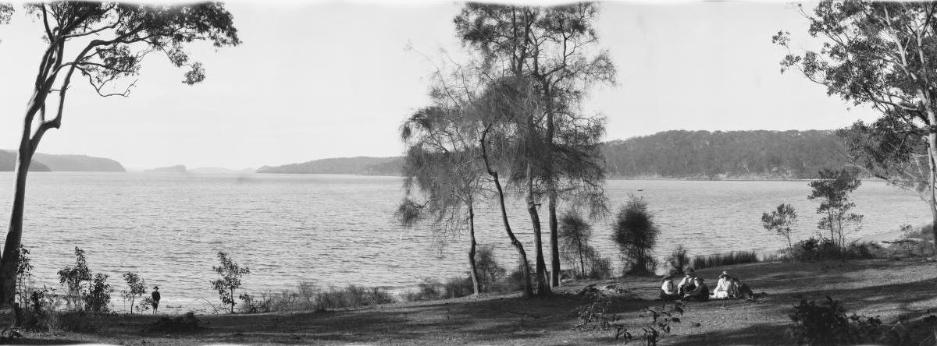
Panorama of Taylors Point, Pittwater, New South Wales, between 1917 and 1946. Part of Enemark collection of panoramic photographs [1917-1946] nla.pic-vn6149430 and Below: section from above - courtesy National Library of Australia.
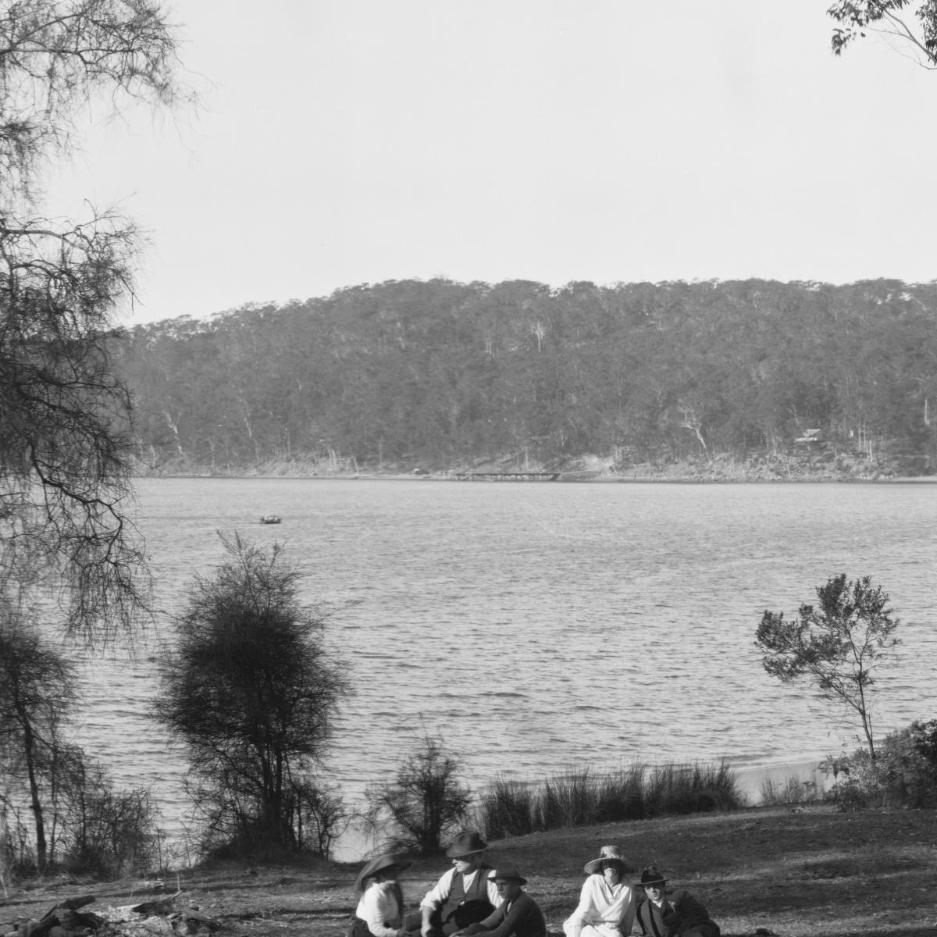
Before roads were built the best means of communication with Pittwater was on the sea lanes. Ferries, coastal traders and smaller boats regularly plied between Sydney Harbour and Pittwater – many of them travelling up the Hawkesbury River and over to the Central Coast, delivering mail, delivering goods and picking up produce to return these to markets in town.
The recent 125th celebration of the construction of a railway bridge over the Hawkesbury also signalled, in one way, the beginning of the end for all those ferries who had carried mail until that time. The trains, supported and promoted by the then existing agency 'The Government Tourist Bureau', although they included trips on ferries from the train depot at Brooklyn down the Hawkesbury to Pittwater, and ‘excursionists’ holiday trips continued from Sydney Harbour, the days of multiple ferries offering similar trips to Pittwater and the Hawkesbury as day excursions, complete with bands aboard, would shift shortly after and change to become ferry services within Pittwater so each side, eastern and western, could be liked.
We have run full pages on some of these ferries, the days they would travel to Pittwater (timetables), and some of the long wending ways they travelled along when sold to vendors in others states. Part of their function in establishing Communications with Pittwater may be seen in the instance of the Florrie as outlined in The Mail Route to Pittwater and Beyond.
In Australia's First Steamers it seems there was a lapse of almost four decades between the first 'ferry' and the explosion of vessels once steamers came along:
The Rose Hill Packet was the first vessel that could be considered as a ferry, indeed she was also the first 'large' vessel built in Sydney. Built by Robinson Reid (carpenter on the Supply), she was launched on the 5th of October 1789 from the King's Slipway (on the current location of Customs House). Due to inadequate tools and poor local timber, the new vessel was little more than a bed of wood and somewhat ungainly earning the nickname of 'The Lump' rather quickly.
Described as a hoy, she was propelled by a single sail on one mast and propelled with the assistance of oars. A journey to and from Parramatta often took the best part of a week - and more often than not passengers had to assist in the task of rowing the vessel. She could carry up to 10 tons of cargo and 30 passengers (probably not at the same time though) and although her exact dimensions are unknown, from her description she was around 38 to 42 feet in length and with a very shallow draught.
However ugly she may have been she was succesful in her role and operated until 1800 before being replaced with more agile (and better built) government vessels, hoys, sloops and pulling boats.
From The Encyclopedia of Sydney Ferries website.
Pittwater, without the coasters travelling south, or people prepared to travel the long way around, was a world unto herself:
William Blue is generally regarded as our first ferryman. History is on familiar terms with him. It usually refers to him as Billy Blue. He gave his name, without prejudice to Blue's Point. But before his time there had been unofficial ferrymen to whom the traveller could say "And I'll give thee a silver pound to row us o'er the ferry."
First attempt at a ferry service was from Sydney to Parramatta. It was inaugurated by a speedboat named the Rose Hill Packet, but known as "The Lump." She was locally built, had both sails and oars, and such a turn of speed that at times she made the journey in less than a week. By the time the colony was only five years old there were a number of boats ready to ply for hire across the blue waters and among the green inlets of Port Jackson. BUT Billy Blue, about 1830, established the first regular service. It paddled its way from Dawes Point on the south side of the harbour to Blue's Point, on the North Shore. As often as not the boatmen, having but recently visited the old Ship Inn would go to sleep in the bottom of the boat. Passengers were then at liberty to row them-selves and the drunken sailors, across to their destination. There was no additional charge for this privilege.
In 1830, also, Barney Kearns ran a ferry, to a set time-table, from Balmoral to Balgowlah, to serve the needs of the Pittwater pioneers.
That same year saw the advent of a queer craft which coyly called itself The Experiment. It had a paddle-wheel, the main motive power for which was a capstan, turned by four horses walking round and round on deck. It also had a pressure contrivance with a wooden plug, which a man had to watch continuously because the plug would blow out when pressure became excessive. It is not known whetherthis alarmed the horses, or whetherthey came to the conclusion that this was a dead-end job, but they gave so much trouble that The Experiment was a failure.
The following year the Surprise was launched at Neutral Bay. It was our first steamer and was even more of a speedboat than the Rose Hill Packet. When in the mood it could make the trip to Parramatta in something under four hours.
Commercial organisation of ferry traffic began in 1833, when the Australian [Steam?] Conveyance Company was formed. Within three years it was making a profit of 38 per cent. The early thirties of last century, due to the advent of steam, saw the advent of ferries run on a business rather than a personal basis.
One such business venture was the Parramatta Ferry Company, which included Balmain in its places of call, and which ran a boat called The Waterman. That was in 1840, and within another 20 years ferries had become established as a feature of the harbour.
Billy Blue Was Father Of The Ferries - By BARTLETT ADAMSON. "HERALD" SATURDAY MAGAZINE. (1951, March 10). The Sydney Morning Herald (NSW : 1842 - 1954), p. 11. Retrieved from http://nla.gov.au/nla.news-article18203322
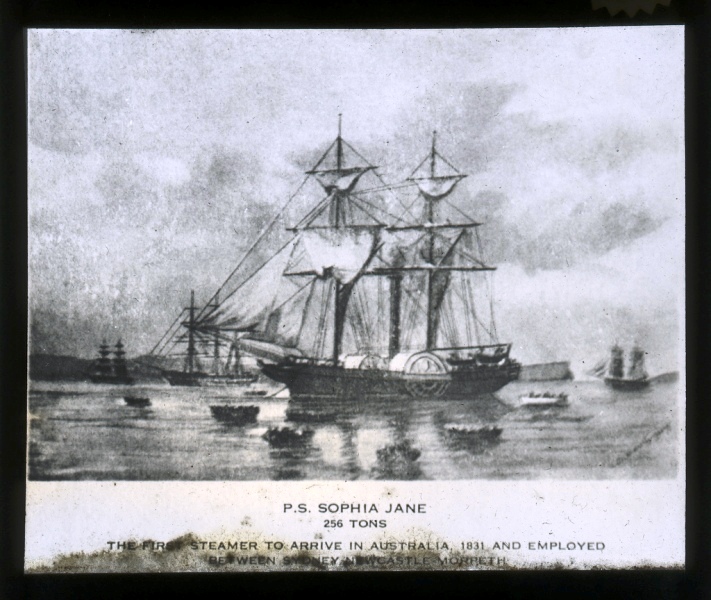
Sophia Jane, original plate, 1841.
Other early ferries pages are: Steamers of Pittwater Part I - History , Pittwater Regattas Part I - Dates and Flagships to 1950 - History, the P.S. Namoi, S.S. Charlotte Fenwick , S.S. Erringhi, SS Florrie History, SS Phoenix and General Gordon Paddlewheeler , MV Reliance, The Elvina and even the S.Y. Ena I, II and III for the range of years and history this vessel covers among her numerous versions and visits to Pittwater and the Hawkesbury. We will add to these pages in celebrations of other wonderful Pittwater vessels in Spring this year.
This page is about exploring the first 'ferries' to Pittwater as much as who may have been out on the Pittwater from our earliest recordings of people here, who organised these vessels to come here, why they came. Pittwater, the Hawkesbury and the Ettalong were interlinked as places where produce much needed could be moved from. Getting fresh produce, such as fish and fruits, required a speedier, gentler method and although the 'farm land', cutting of timber, gathering shells to make lime indicates a sparsely occupied Pittwater, those that were here seemed to be pretty busy. Coasters owned by those who lived here and ships on their way up and down the coast were frequent visitors :
At Windsor, on Thursday the 27th instant and two following Days, on the Premises of the late Andrew Thompson, Esq. (by Order of the Executors), A VALUABLE and ASSORTED STOCK of GOODS, consisting of Tanned Leather, Shoes, Harness and Sadlery, Shoemakers, Blacksmiths, and Carpenters' Tools, Hemp and Flax, a general assortment of Manchester and India goods, Medicines, Copperas, Brimstone, Rosin, Tar, Salt, Tobacco, Hardware, Stationary, and numerous other Articles.
ALSO, the valuable and useful Household Furniture, comprising good feather beds, bedding, and bedsteads, sofas and sofa covers, window curtains, Pembroke and dining tables, chairs, chests of drawers, writing desks, pier and dressing room looking glasses, table and bed linen, earthen ware, glass, kitchen utensils, steel mills, large beam, scales and weight ALSO, six new Boats of different dimensions, one Punt, seven Saddle and Draught Horses, a number of fine Pigs, a single Horse Chaise and Harness, Waggons, Carts, and a variety of Implements of Husbandry, calculated for carrying on the most extensive Farms in this Colony. For the Accommodation of Purchasers, Three Months Credit will be given on approved Security, on all Sums exceeding Ten Pounds –A Deposit of 25 per cent, to be paid at the time of Sale, in Cash, Government, or other approved Sterling Money.
AT the same Time will be LET by AUCTION, for a Term of Two Years, if not previously disposed of by Private Contract, the valuable House and Premises late the Residence of A. THOMPSON, Esq. deceased, situate at Windsor, comprising a good Dwelling House, Stores, Granaries, Cellars, Stabling, and other convenient and spacious Warehouses, adapted to the beneficial Trade of the extensive and populous. Settlement at the Hawkesbury.
ALSO, a valuable Farm situate on the Banks of the South Creek, adjoining the Town of Windsor, known by the name of West-hill Farm, comprising good Dwellings, Granaries, Stores, Stabling, a large Tan-yard, Barn, Gardens, Yards, and every other convenience attached, suitable to the Farming Line.
ALSO, several fertile Farms in high cultivation, commonly called Agness and Wardle Banks, situate in the District of the Nepean, with fine Orchards of choice early bearing Fruit Trees.
ALSO, an extensive Grazing Farm, known by the name of Killarney, situate on the Banks of Bardo-narang, on which is a good Brick Dwelling House, with Cellars, Dairy, &c. good Stockyards well adapted for Horned Cattle or Sheep. ALSO a large Brewery at Windsor, situate on the Banks of the South Creek, with Malt-kiln, Granary, Cooperage, and every useful Utensil for prosecuting the Brewing Business on an extensive Plan. ALSO, the Toll Bridge over the South Creek. ALSO about Two Acres of Land, situate at Windsor, opposite the Brick House, inclosed for a Garden; together with those valuable Salt-works at Scotland Island, Pitt-water, with a Dwelling-house and other requisite Buildings attached. Further Particulars may be known on application to Captain Antill or Thomas Moore, Esq. Executors ; Mrs J. Howe at Windsor; or of the Auctioneer at Sydney. Classified Advertising. (1810, December 15). The Sydney Gazette and New South Wales Advertiser (NSW : 1803 - 1842), p. 2. Retrieved from http://nla.gov.au/nla.news-article628145
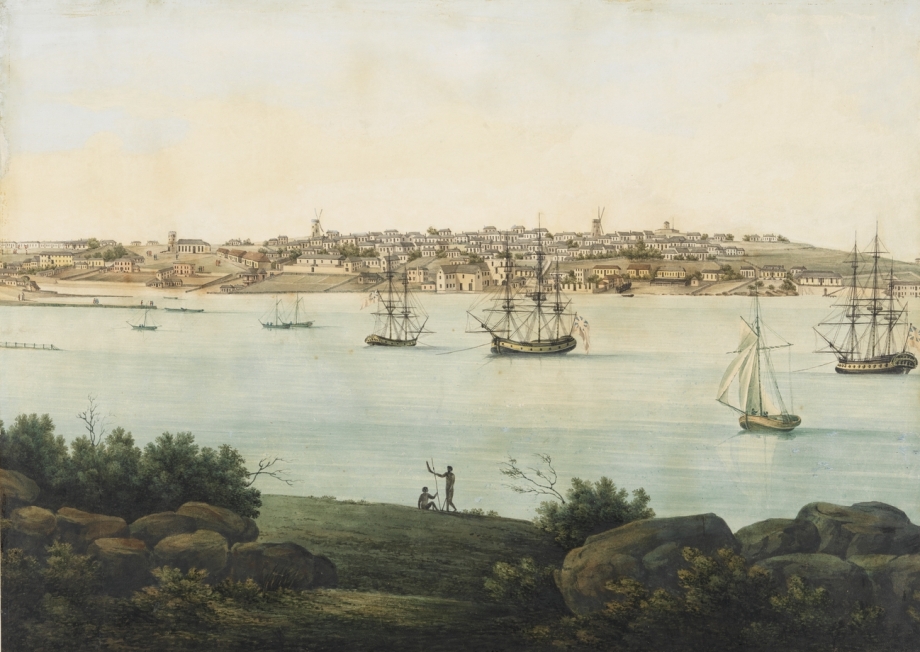
Sydney Cove, West side, 1810 [attributed to G.W. Evans]Digital Order Number: a9010001, courtesy State Library of NSW.
TO be LET or SOLD, all that valuable ESTATE, called SCOTLAND ISLAND, most eligibly situate in Pittwater, containing about 150 Acres of capital Land, with an excellent House and Out-Building standing thereon.-This Land possesses many Advantages peculiar to itself, particularly in Regard to Ship Buildings ; and there are Salt Works now erected thereon, which may be carried on to great Advantages.-Apply to the Proprietor, Mr. R. L. MURRAY, Sydney. Classified Advertising. (1819, August 21). The Sydney Gazette and New South Wales Advertiser (NSW : 1803 - 1842), p. 2. Retrieved from http://nla.gov.au/nla.news-article2178904
On Saturday last five bush-rangers were sent from the Court-house at Parramatta in the custody of a peace officer, apparently well and sufficiently secured in Parks's passage-boat, with the intention of their being safely lodged in the county gaol, in order to their being tried at the ensuing Criminal Court for various offences with which they were charged. On their way down, however, they managed to become disentangled from their irons, and freed of their manacles to disarm the constable; and to take possession of the boat. One of them, whose name is Geary, and a dreadfully determined desperado, insisted upon Parks landing them at Bradley's Wharf at Lane Cove, which was necessarily complied with ; as the least shew to resistance would have been useless, and might, in all probability, have been attended with serious consequences. Geary, the ringleader, who has been guilty of many crimes, and who has endeavoured frequently to make his escape from the Colony, declared it was their united intention to use any and every effort to escape this time; they gave Parks a dollar; and then decamped, informing the constable he had only performed his duty, which of course, they intimated, had shielded him from their malevolent fury. Upon the arrival of the passage-boat in-Sydney, immediate information was given to the Marine Police Authority of the circumstance ; & it was in consequence deemed expedient, with as little delay as possible, to dispatch the government row-guard boat, under the command of the Messrs. Cubitts, round to Broken Bay, at which place the Elizabeth Henrietta (government brig) with prisoners on board for Newcastle, and the Prince Regent (government schooner) was also lying, at a considerable distance from the brig, in Pittwater. The latter was but thinly manned, part of the crew being unavoidably absent; and it was supposed, had such determined gang, well armed as they are known to be, made an attack upon her in so defenceless a condition as she then was, a capture must have been the co-sequence; but the customary activity being resorted to, in a prompt obedience to the instructions given, the guard-boat succeeded in getting round to Broken Bay in time to prevent any unpleasant disaster. Every alarm was made throughout the various farms in the district of Broken Bay, so that it should speedily run along the Hawkesbury Banks; and the Prince Regent remained under the protection of the guard-boat.
Tuesday morning, when she took her departure from Broken Bay; and on Wednesday the guard-boat returned to port, wholly unsuccessful, however, in having gained the least tidings of the absentees ; who by this time, it is to be feared, have increased in strength. It is ardently to be hoped, that every friend to honesty and humanity will not spare any exertion or pains to prevent such a gang of villains prowling at large to the destruction of the lonely settler's peace, and to the encouragement of every species of depravity. We cannot avoid remarking, that it is much to be dreaded as a truth beyond the possibility of contradiction, that such pests to the general weal are harboured by the settler and others at the out-stations; and while encouragement and protection are held out to the determined villain by those who ought to suppress robbery, sometimes followed by murder, who can possibly guard against, or prevent the atrocities that are occasionally perpetrated ? It would be well if the owners of boats would attend, for a time at least, to the beneficial Regulation that affects their interests, bearing date the 15th of May, 1813, and which expressly requires "All shore-boats to be moored and chained at night, and their oars safely lodged, on penalty of 10s. the first, and 20s. each succeeding offence.” Sydney. (1821, March 10). The Sydney Gazette and New South Wales Advertiser (NSW : 1803 - 1842), p. 2. Retrieved from http://nla.gov.au/nla.news-article2180137
The passengers were landed at a small, but commodious wharf, erected on the property of the Venerable J. J Therry, under whose especial patronage the excursion had been got up. Most of the visitors set off in quest of St. Michael's Cave, determined not to lose the opportunity of seeing so great a natural curiosity. The walk, it was found, lay through woods, a long flat, and a hilly scrub, until, facing to the east at the head of the inlet, the merry party, in a straggling Indian file, at length arrived in the vicinity of the cave, cautiously descending the rocks, and creeping carefully along a narrow path specially made for their convenience on the face of the cliffs, they were thus finally rewarded for their perseverance. Almost every body managed to scramble up into the cave, and not a few of the more adventurous explored its inmost recesses by candle-light. The effect of the gloomy inner arch looked down upon from the top of the second angle of the cave, was much admired; and so also was the wider arch at the entrance, as contemplated from the spot where the bright daylight again began to stream down upon the faces of the returning explorers. There was, for some time, a pleasant buzz of conversation and a discussion of food at the mouth of St Michael's Cave, and then the party set out on their way back to the steamer, where dinner had been prepared.
Some with sharpened
appetites posted thither at once, but many remained with the band near
the house on the flat, and amused themselves with dancing, playing cricket, and
so on. There was some dancing also at the steamer after dinner was
over. The Kembla steamer visited the wharf at an early hour, landed some
passengers, and afterwards returned for them. The Collaroy left the
wharf for Sydney at about five o'clock, and arrived safe at Sydney soon after
eight. The Right Worshipful the Mayor of Sydney, the Mayoress, and other
members of the family were on board. We also observed the Rev. Fathers Corish,
Curtis, Hanson, and Powell, besides the Venerable J. J. Therry. The
trip appeared to give general satisfaction, although a slight shower, soon after
the arrival of the Collaroy at Pitt Water, interfered with some of the
arrangements.
PITT WATER. (1862, April 22). The
Sydney Morning Herald (NSW : 1842 - 1954), p. 4. Retrieved from http://nla.gov.au/nla.news-article13227471
EXCURSION TO BROKEN BAY.
ONE of the most attractive of the provisions made for the enjoyment of New Year's Day, was an excursion to Pittwater and the mouth of the Hawkesbury, in the Illawarra Steam Navigation Company's fast and commodious steamer Hunter. The genial fineness of the weather and the smoothness of the water, offered potent inducements to those who were familiar with all the holiday resorts in the vicinity of Sydney to pay a visit to Broken Bay. The Hunter was accordingly well filled for the trip-indeed, too well filled, as the passengers were in excess of the sitting accommodation. As the excursion was determined on several days ago, the company's largest steamer should have been engaged. There were upwards of three hundred passengers on board, and that number would have been comfortably accommodated in the Kembla. The Hunter left the Phoenix Wharf, under the command of Captain Keft, shortly before eleven o'clock, and reached Broken Bay about one o'clock. On dropping anchor off the Customs Station, Mr. Ross, the coastwaiter came on board and offered his services to pilot the steamer to a part of the Bay where the passengers would, on landing be able to visit the cave and the hole in the rock, objects of much interest to tourists. Some of the party who were acquainted with the locality, stated that that would be the best place to land the excursionists, on account of the vicinity of the cave, and also of the excellent sport obtainable in the way of shooting and angling ; it was, however, decided to take the steamer to the small inlet at Pittwater. Here the boats were lowered, and about half the passengers landed and dispelled in small groups. Most of those who had provided themselves for the excursion soon found out the most cozy nooks under the shade of the rocks, and made hearty meals in the true picnic fashion. The remainder of the afternoon was spent by some of the party in clambering the abrupt embankments and gathering the splendid ferns and palms growing in wild luxuriance; by others in fishing and oystering, and by a few in collecting sea weeds while the less curious preferred a siesta in the cool shade. In the meantime, the steamer left Pittwater and proceeded for a few miles up the Hawkesbury - not far enough, however, to give the expectant excursionists a very impressive idea of the much-extolled scenery of that river. On returning to Pittwater many of the passengers went ashore and enjoyed a stroll along the beach,-the whole of the party re-embarking soon after five o'clock. A few minutes before six the Hunter steamed out of Broken Bay, and landed all her passengers in safety at eight o'clock. During the outward passage, the wind being light, the motion of the vessel was the occasion of discomfort to very few on board but, on returning, there was rather more motion, though the sea was by no means rough, and the distressing effects were widely experienced- the more so on account of the crowded decks. As the sea voyage was little above an hour in duration, the sea sickness was looked upon as a comparatively trifling inconvenience, and, excepting that there was no band on board, it constituted the only drawback to an extremely pleasant and propitious excursion. The decided success that has attended the trips of the Kembla and the Hunter to Broken Bay will, probably, have the effect of rendering that spot a regular holiday resort in future. EXCURSION TO BROKEN BAY. (1862, January 2). The Sydney Morning Herald (NSW : 1842 - 1954), p. 4. Retrieved from http://nla.gov.au/nla.news-article13069605
Broken BAY.-There are to be two pleasure trips to Broken Bay and Pittwater today; the Kembla, starting at ten, from the Phoenix Wharf, and the Grafton, steamer, from the Grafton Wharf. WATER POLICE COURT. (1862, January 27). The Sydney Morning Herald (NSW : 1842 - 1954), p. 4. Retrieved from http://nla.gov.au/nla.news-article13223850
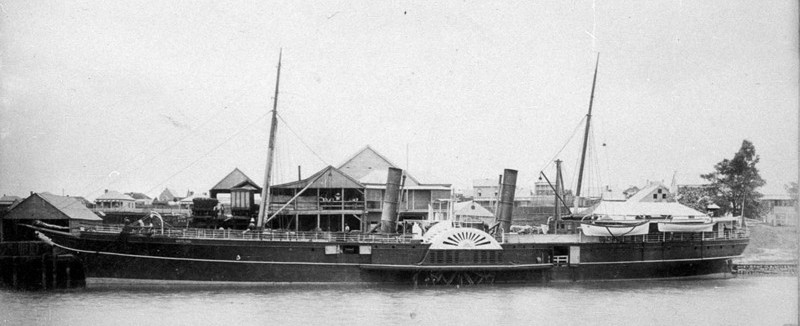
SS Maitland, 1884, at Maitland wharf! Image no: BCP 05329, courtesy State Library of NSW.
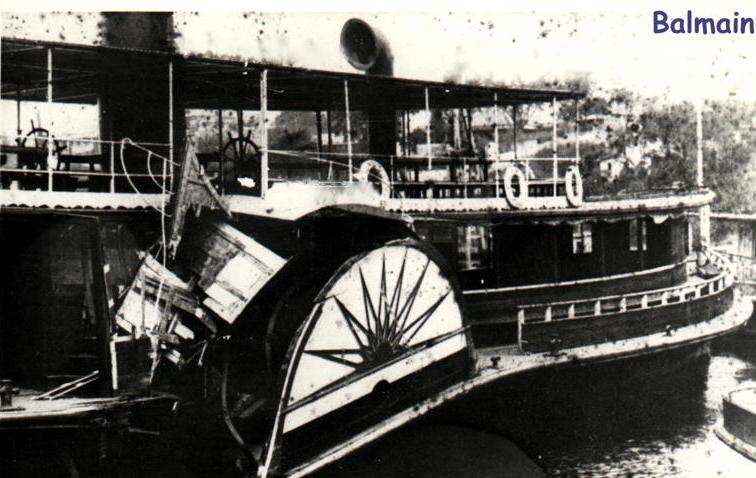 The Maitland left
the wharf in Darling Harbour crowded with passengers bound for Newport and-
Peat's Ferry. THE HAWKESBURY TRIP. (1890, January 28
TUESDAY). The Sydney Morning Herald (NSW : 1842 - 1954), p. 6.
Retrieved fromhttp://nla.gov.au/nla.news-article13757590
The Maitland left
the wharf in Darling Harbour crowded with passengers bound for Newport and-
Peat's Ferry. THE HAWKESBURY TRIP. (1890, January 28
TUESDAY). The Sydney Morning Herald (NSW : 1842 - 1954), p. 6.
Retrieved fromhttp://nla.gov.au/nla.news-article13757590
Captain Knowles, of the Namoi, in concert with the Gwydir, landed his passengers at the jetty at Newport, and gave them a run on shore for about three hours, which was most thoroughly enjoyed. The Namoi was the first steamer to arrive in port, followed closely by the s.s. Gwydir and immediately in the latter's wake came the S.S. Balmain. The excursionists speaking the highest of praise in all cases of the attendance they received on board, from the respective commanders downwards. It is pleasing to relate that no accident ocourred throughout, the weather fine, the sea smooth, and a most enjoyable day was spent. OCEAN EXCURSIONS. (1890, April 8). The Sydney Morning Herald (NSW : 1842 - 1954), p. 6. Retrieved from http://nla.gov.au/nla.news-article13766008
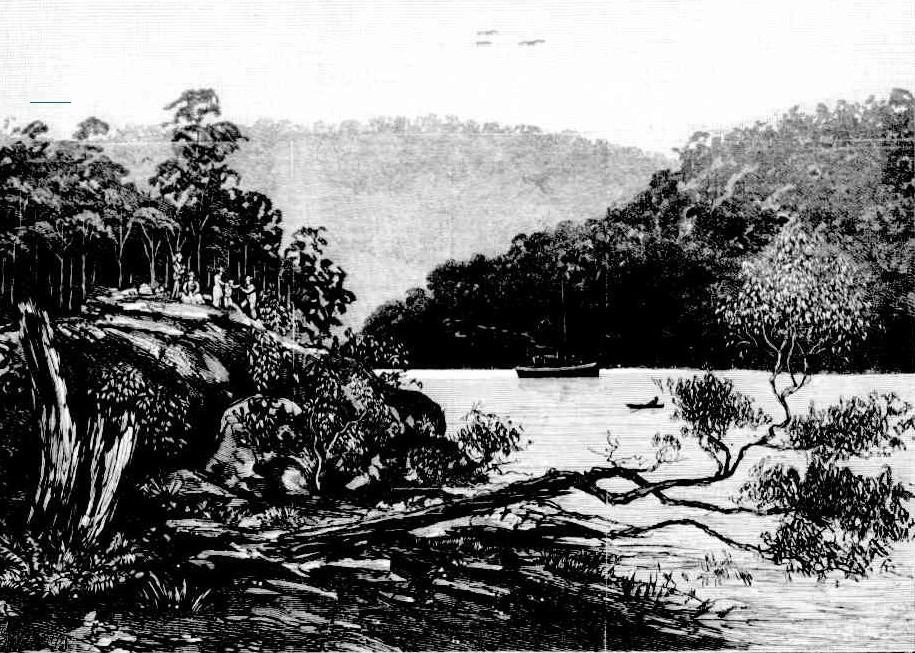
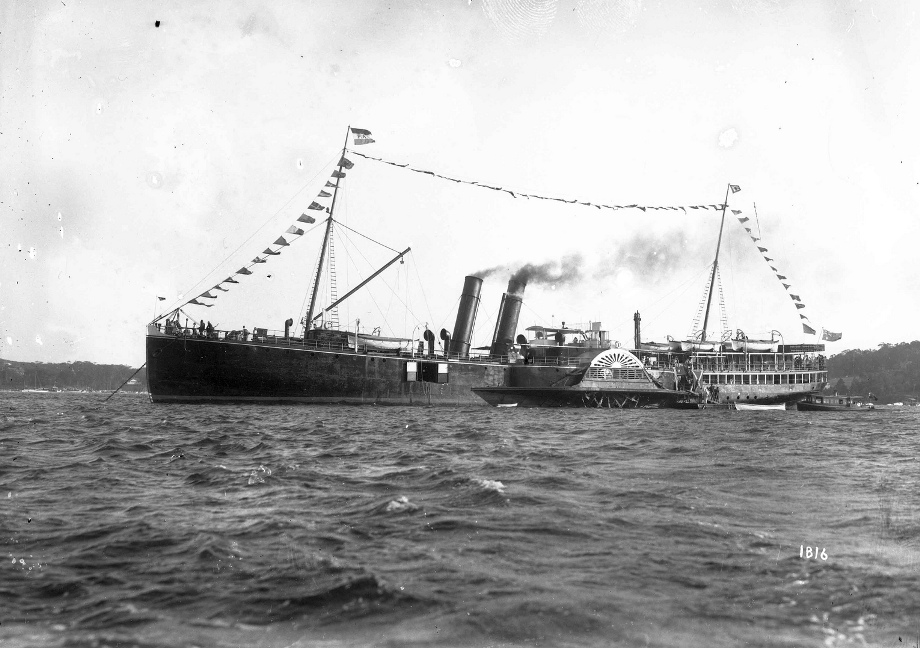
To be Registered, and the Liability of the Shareholders Limited under the Companies' Act. The above Company is proposed to be formed for the purpose of establishing a regular and efficient Steamship Service between Sydney, Pittwater, and various places upon the Hawkesbury River. It is proposed that the Company purchase the steamers and wharfage rights of Mr. C. E. Jeanneret and Messrs. Melvey and Ford, who are now conducting the passenger and goods traffic between Sydney, Pittwater, and the Hawkesbury River. The purchase will also include the goodwill of the business carried on by Mr. Jeanneret and that of Messrs. Melvey and Ford. The steamer Amy will be sold to the Company by Mr. Jeanneret and the Moramara by Messrs. Melvey and Ford.
The wharfage rights of the vendors consist of- '
1. The occupation by lease of a wharf at Peat's Ferry at, present held by Mr. Jeanneret.
2. The lease of a wharf in course of construction at Peat's Ferry held by Messrs. Melvey and Ford.
3. A "Wharf at Flat Rock Point upon the Hawkesbury River, held by Mr. Jeanneret, from the Crown.
4. Freehold land at Newport with Wharf, known as Victoria wharf.
5. The wharfage right of Mr. C. E, Jeanneret for the unexpired residue of the term of two years over portion of No. 4 Jetty, Circular Quay, Sydney, for the purpose of embarking passengers and their goods.
In addition to the above properties a Cottage and Water Tank at the Basin, Pittwater, as now held under licence from the Crown will be transferred to the Company.
The Vendors can also arrange with the Company for storage and wharfage of goods if required, at a fixed rate.
The capital of the Company will be £10,000 divided into 10,000 shares of £1 each. Of these 4000 will be allotted as fully paid up to the vendors, Messrs. C. E. Jeanneret and Messrs. Melvey and Ford, and the balance of 6000 shares will be offered to the public upon the following terms of… Advertising. (1885, August 29). Australian Town and Country Journal (NSW : 1870 - 1907), p. 8. Retrieved from http://nla.gov.au/nla.news-article70983085
Born in Sydney in 1834 the eldest son of Dr. Henry Jeanneret he grew up on Flinders Island, then a protectorate of Tasmania, where his father had the title of ‘Commandant’ as well as ‘Superintendant of Aborigines’. Here he learnt navigation and seamanship. After stints at sea, sailing to England at 18 and on the goldfields in Bendigo he returned to Sydney in 1850, joined the Bank of New South Wales and married Julia Anne Bellingham in 1857, settling at Hunter’s Hill. They had eight sons and two daughters, the youngest of these, born in 1879 was named Florence Annie. Besides being responsible for the building of many lovely houses at Hunter’s Hill and elsewhere, being attributed with a great avenue of trees in this suburb and the construction, later, of a tramway, C E Jeanneret heard the complaints of fruitgrowers in this area on the then existing ferry service for their produce down the Parramatta River to Sydney markets.
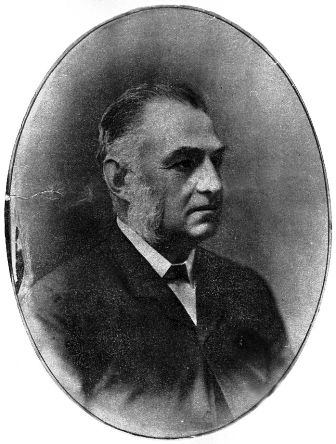 Reminiscences.
The Late Mr. Jeaneret. History of the Parramatta Steamer Company. The late Mr.
Alderman Jeanneret's career had an important bearing in the development of the
passenger traffic on the Parramatta River and elsewhere. The original
proprietors of the Parramatta steamers were Mr. E. D. Manning, Sir William
Manning, Mr. J. S. Mort, Mess.rs. J. and W. Asyrnes, and it was about 30 years
ago that Mr, Jeanneret came upon the scene and that his influence was felt in
connection with the river traffic. At that time the Hunter's Hill people
expressed great dissatisfaction with the arrangements of the original Parramatta
Steamship Company, and this culminated in Messrs. Jeanneret, Joubert and others
running a small steamer called the' Tsabel’ from Hunter’s Hill to Sydney.
Success attended the venture, and, soon after, the s.s. Adelaide, procured in
Melbourne, and engined in Sydney was added to the service. The enterprising
owners then floated a company in opposition to the old company. Almost the whole
of the fruitgrowers of the Ryde district, from those at Ermington to those of
Hunter's Hill took tip shares in the company to the extent of £5 and under. Mr.
Jeanneret was unanimously selected as Manager, a position for which he proved
himself eminently fitted. The two companies now entered into a keen competition,
with the usual result that both lost heavily, and in less than two years there
was an amalgamation, Mr. Jeanneret being selected as manager of the combined
fleets. Soon after the amalgamation, the members of the old company disposed of
the whole of their shares in the boats, and the new company were therefore left
masters of the situation.
Reminiscences.
The Late Mr. Jeaneret. History of the Parramatta Steamer Company. The late Mr.
Alderman Jeanneret's career had an important bearing in the development of the
passenger traffic on the Parramatta River and elsewhere. The original
proprietors of the Parramatta steamers were Mr. E. D. Manning, Sir William
Manning, Mr. J. S. Mort, Mess.rs. J. and W. Asyrnes, and it was about 30 years
ago that Mr, Jeanneret came upon the scene and that his influence was felt in
connection with the river traffic. At that time the Hunter's Hill people
expressed great dissatisfaction with the arrangements of the original Parramatta
Steamship Company, and this culminated in Messrs. Jeanneret, Joubert and others
running a small steamer called the' Tsabel’ from Hunter’s Hill to Sydney.
Success attended the venture, and, soon after, the s.s. Adelaide, procured in
Melbourne, and engined in Sydney was added to the service. The enterprising
owners then floated a company in opposition to the old company. Almost the whole
of the fruitgrowers of the Ryde district, from those at Ermington to those of
Hunter's Hill took tip shares in the company to the extent of £5 and under. Mr.
Jeanneret was unanimously selected as Manager, a position for which he proved
himself eminently fitted. The two companies now entered into a keen competition,
with the usual result that both lost heavily, and in less than two years there
was an amalgamation, Mr. Jeanneret being selected as manager of the combined
fleets. Soon after the amalgamation, the members of the old company disposed of
the whole of their shares in the boats, and the new company were therefore left
masters of the situation.
Owing, however, to the heavy expenses, incidental chiefly to the working of the old steamers, whose earnings did not give an adequate return for the outlay, the victorious company found after a time that it could not meet its liabilities. Tenders were invited for the purchase of the fleet, which was sold to the highest bidder — the energetic and enterprising C.E. Jeanneret. He continued running the steamers successfully, the time proving exceedingly opportune for the venture. Those were the good old times when railway construction was in full swing, and large sums of money were being expended in the building of bridges, so that traffic on the river was very considerable. He continued the service for many years at a profit, and added considerably to the fleet both by purchases and the building of new steamers, bringing the number of vessels in the service up to 20. It was he who built the Halycon, Eagle, Eclipse, Nautilus, Osprey, Neutral Bay and, lastly, the Pheasant.
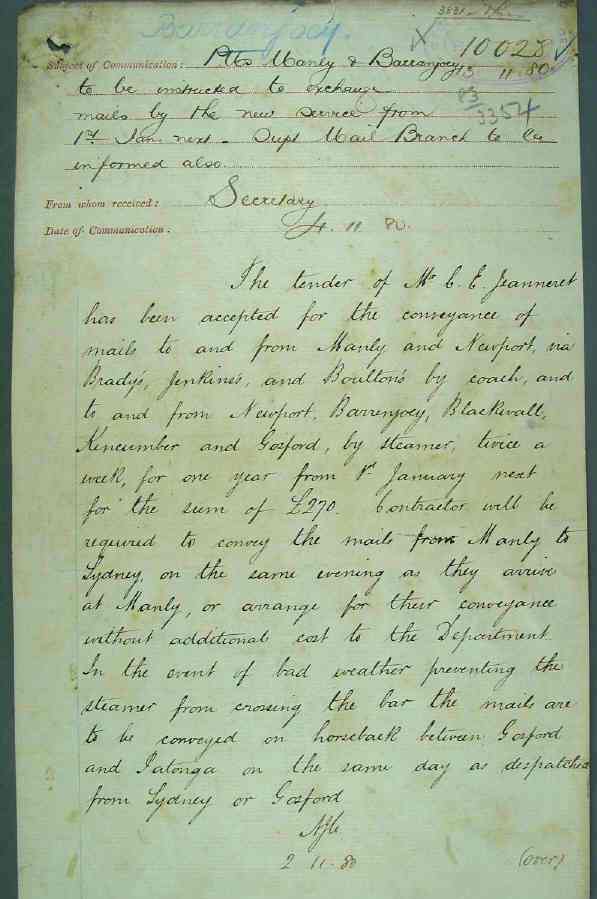 He
sold three or four of his steamers to the Adelaide Company (incorrect; see further down 1.). Of
the 20 vessels in his service half-a-dozen were employed on the Parramatta
River, the others running to Gosford, Neutral Bay, Iron Cove, Hawkesbury River,
etc. It was the late Mr.' Jeanneret who opened up the Iron Cove service and also
the service to and from Woolwich. Another boat he built was the s.s. Gosford
which was afterwards sold at a satisfactory figure. During the good times an
English syndicate made an offer for the purchase of Mr. Jeanneret's entire
fleet, and he went to England in 1890 to treat with the syndicate. The result
was that he sold out, severing entirely
his connection with the service which he had worked up to a high state of
proficiency. He made his home at Hunter's Hill, which he regarded as ' the apple
of his eye ' from the time he first saw it.
He
sold three or four of his steamers to the Adelaide Company (incorrect; see further down 1.). Of
the 20 vessels in his service half-a-dozen were employed on the Parramatta
River, the others running to Gosford, Neutral Bay, Iron Cove, Hawkesbury River,
etc. It was the late Mr.' Jeanneret who opened up the Iron Cove service and also
the service to and from Woolwich. Another boat he built was the s.s. Gosford
which was afterwards sold at a satisfactory figure. During the good times an
English syndicate made an offer for the purchase of Mr. Jeanneret's entire
fleet, and he went to England in 1890 to treat with the syndicate. The result
was that he sold out, severing entirely
his connection with the service which he had worked up to a high state of
proficiency. He made his home at Hunter's Hill, which he regarded as ' the apple
of his eye ' from the time he first saw it.
He was always a shrewd business man, and of him it might almost be said that he ' made Hunter's Hill.' He built a great many villa residences on the Hill; in fact, no single individual has spent so much money in property in that borough as he. It was due to his influence that the Post and Telegraph offices were built at Hunter's Hill, and they are certainly a credit to the place. In conclusion, it may be added that of the officers or men employed by the old Parramatta company that opened up the river service, the genial and ever-obliging Captain Mance is the only one now remaining in the service. He is known as the Commodore of the fleet, a distinction to which he is well entitled. Reminiscences. (1898, September 10). The Cumberland Argus and Fruitgrowers Advocate(Parramatta, NSW : 1888 - 1950), p. 6. Retrieved from http://nla.gov.au/nla.news-article85845277
Extending his growing fleet’s services to Pittwater, the Hawkesbury River and ensuring these were used on the days and times when they weren’t scheduled for the Royal Mail run would have seemed logical to such an entrepreneur. The Florrie became a fixture on Pittwater and the Hawkesbury, bringing holiday day trippers and picnickers to Pittwater. It was the Florrie who transported the official party to the Customs wharf to lay the foundation stone for Barrenjoey Lighthouse;
LAYING the FOUNDATION-STONE of a NEW LIGHTHOUSE at BARRENJOEY (By OUR OWN REFORTER.) The ceremony of laying the comer-stone of the new lighthouse at Barrenjoey was performed on Thursday, by Miss Rosa Barnet, daughter of the Colonial Architect, and everything connected therewith passed off in a highly satisfactory manner. ...
The contractor issued invitations to several ladies and gentlemen to be present, and among those who responded there to were Messrs. J. S. Farnell, E. Greville, and J.Hurley, M.L.A., Captain Hixson, and Messrs. Thompson, Whiting, Jeannerett, Wilson, Walker, Barnet and Spencer. Mrs. and Miss Barnet and several other ladies were also present. The party left the Circular Quay at a quarter past 7 o'clock, in the steamer Emu (Jeanneret owned), for Manly Beach, whence they were to go overland in vehicles... LAYING the FOUNDATION-STONE of a NEW LIGHTHOUSE at BARRENJOEY. (1880, April 17). The Sydney Morning Herald (NSW : 1842 - 1954), p. 7. Retrieved from http://nla.gov.au/nla.news-article13458288
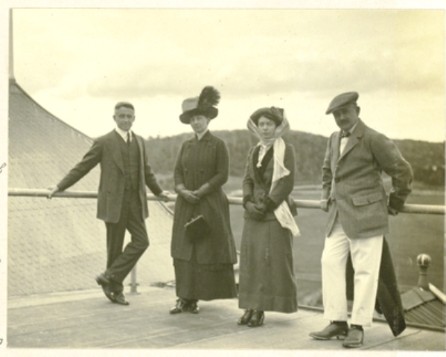
Above: P T Taylor (far right) on balcony of La Corniche, Mona Vale in 1911. Picture a3289053h from the Allen Family Album, image courtesy Mitchell Library, State Library of NSW.
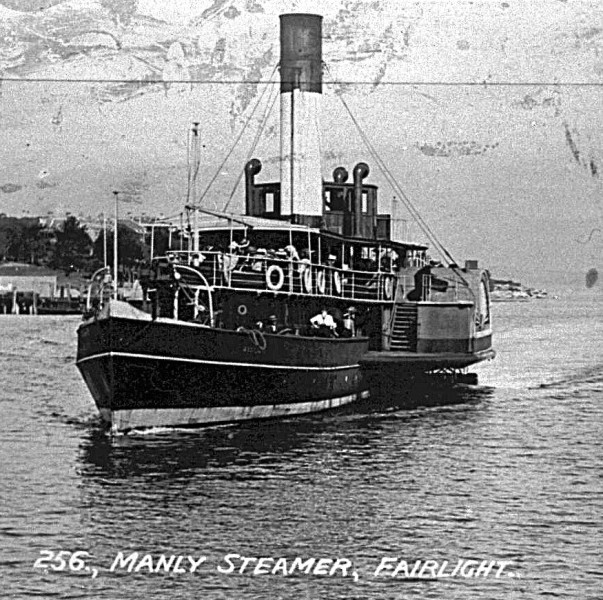 I'm
not of the wilfully adventurous type, you understand; and would no more think of
going deliberately through those adventures between Manly and the head of
navigation on the Hawkesbury, than of starting on a march of discovery into the
interior of New Guinea. There were seven others of the party as it turned out;
strangers to each other at the outset ; and as events proved all were of the
quiet and staid order, who prefer Safety, and would not wilfully pay for
excitement. We got the latter in plenty though. But to begin:
I'm
not of the wilfully adventurous type, you understand; and would no more think of
going deliberately through those adventures between Manly and the head of
navigation on the Hawkesbury, than of starting on a march of discovery into the
interior of New Guinea. There were seven others of the party as it turned out;
strangers to each other at the outset ; and as events proved all were of the
quiet and staid order, who prefer Safety, and would not wilfully pay for
excitement. We got the latter in plenty though. But to begin: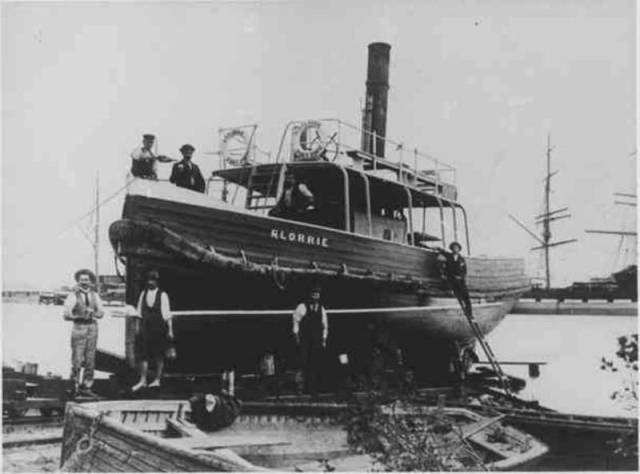 But we got on board the Florrie, and ere long had the
privilege of a series of novelties not set down on the programme of the round
trip to the Hawkesbury. From the start there seemed a want of sympathy and
understanding between the boiler arrangements with moving parts of the
machinery. At times the former would make a big spurt, steam would be hissing
all about, but the going parts would not respond'; and while off the
pilot-station and in the rolling swell of the Pacific influenced by a stiff
southerly breeze, the machinery slowed down sadly, and came to a stand
still.
But we got on board the Florrie, and ere long had the
privilege of a series of novelties not set down on the programme of the round
trip to the Hawkesbury. From the start there seemed a want of sympathy and
understanding between the boiler arrangements with moving parts of the
machinery. At times the former would make a big spurt, steam would be hissing
all about, but the going parts would not respond'; and while off the
pilot-station and in the rolling swell of the Pacific influenced by a stiff
southerly breeze, the machinery slowed down sadly, and came to a stand
still.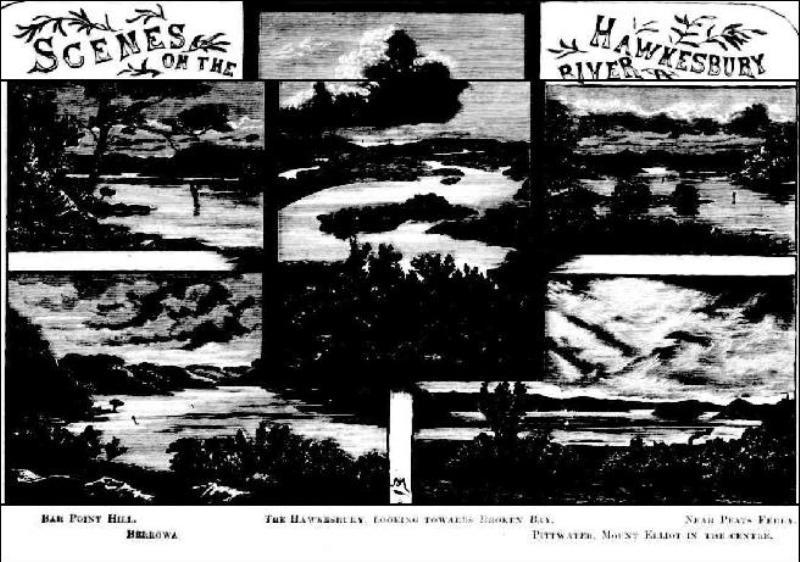
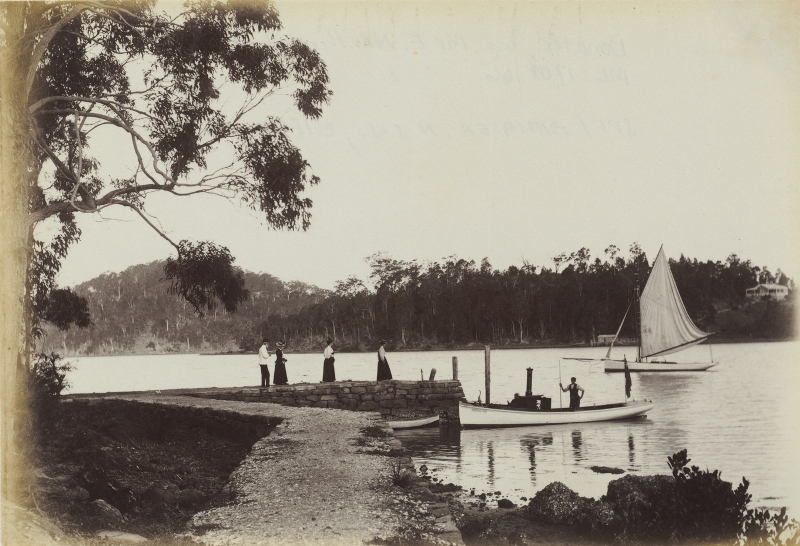
The Kuring-gai Launch at Towlers, circa 1889- Image No.: 1436700H, courtesy State Library of NSW
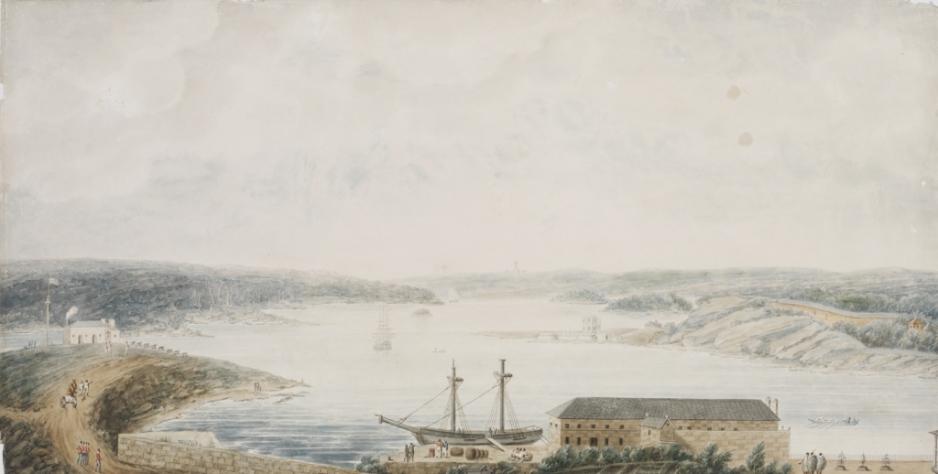
BATHING - HINT TO THE POLICE - On Monday last, no less than six men were at one time bathing between the Dock Yard and Campbell's Wharf; this was about twelve o'clock at noon, and they were not offered the slightest interruption by Water or Land Police. We are as unwilling as others are, to interfere with the amusements or privileges of our fellow colonists, but we cannot help exposing a practice that is as disgusting as it is common; that of exposing one's person at the public wharfs and jettys. Where these men were bathing, is one of the most public places round the harbour, being close to a very crowded thoroughfare. Several persons we are told, are in the habit of bathing at Dawes' Point. We would recommend the Police to be on the qui vive, for we are convinced that the only circumstance that will put a stop to such conduct, will be an example, which would have a better effect than fifty lectures in our newspaper. DOMESTIC INTELLIGENCE. (1841, March 4). The Sydney Gazette and New South Wales Advertiser (NSW : 1803 - 1842), p. 2. Retrieved from http://nla.gov.au/nla.news-article2552683
References and Extras:
- TROVE - National Library of Australia
- State Library of NSW
The Budgambi Post Office.
MR. EDITOR. - I am glad the subject of the new Post Office at Copmanhurst and the suggested change of the name to Budgambi, has called forth remarks in your columns, and judging from the correspondence I have received, it appears that even those who suggested the name of Budgambi did it against their wishes, and unmindful of the ultimate injustice - if not injury - the place might suffer. However, strengthened by the approval of residents, I have to-day communicated with the Secretary of the General Post Office, and trust some action maybe taken to remedy the gross blunder that has been made ; and should the local postal authorities be called upon to suggest change of names for the old and new offices, they will suggest Upper Copman-hurst and Copmanhurst, or some other local and euphonious name for the old office.
As I played a prominent part some years ago in perpetuating the name of Copmanhurst, I will here tell you how that came about. In the early settlement of the Clarence River, Commissiary Grose, of Grose Farm, Sydney, by his manager, Mr. Alfred Lardner, took up a run at the head of navigation of the Clarence River and named it "Copmanhurst." Years after that, and acting upon instructions from the Surveyor-General, I designed and laid out a town upon the site of the old station, which at that time had been merged in the Eatonewill Run. Copmanhurst was proclaimed and allotments sold. Shortly afterwards some farms were measured from the town boundary, embracing Smith's Flat. The land was very rich, and early settlement by farmers followed, and a Post Office was established in a place most convenient to them, and also to Ramornie a large cattle station close by, and the local name, Copmanhurst, was given to the office. This spot is about 2 miles from the town of that name.
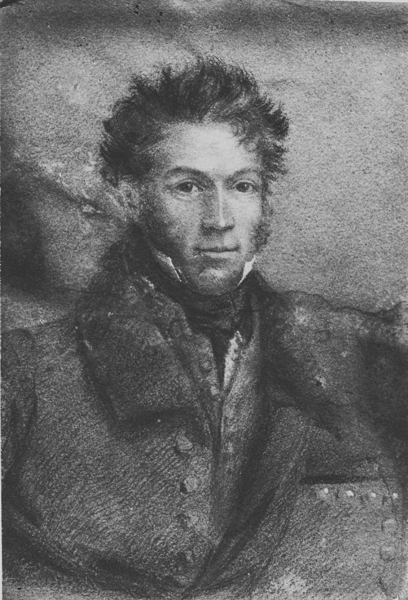 About the year 1839 or '40 Mr. Grose, the owner of the steamer "King
William," entered the Clarence on a voyage of discovery, having on board Captain
Perry (then Deputy Surveyor-General) and others. The river at that time was
attracting considerable attention in Sydney, and was known as the "Big River."
The King William steamed as far as Copmanhurst, where the party landed at
Mr. Grose's station, and Captain Perry named the prominent mountain close by
Mount King William (see chart).Returning to Grafton, then known as " The
Settlement," or " Woolport," it was discovered that the river was in freshet,
and that if the King William had not left when she did she would have stuck
above the Falls, and if there had been no flood in the river since would
probably have been there now. During Mr. and Mrs Lardner's residence at
Copmanhurst the station was the favourite place of caller halfway house between
the runs on the upper portion of the river, and the Settlement. In short, there
was no other, or more, communication than with a flight crows overhead, so that
the home of the hospitable squatter was the only place for rest and
refreshment.
About the year 1839 or '40 Mr. Grose, the owner of the steamer "King
William," entered the Clarence on a voyage of discovery, having on board Captain
Perry (then Deputy Surveyor-General) and others. The river at that time was
attracting considerable attention in Sydney, and was known as the "Big River."
The King William steamed as far as Copmanhurst, where the party landed at
Mr. Grose's station, and Captain Perry named the prominent mountain close by
Mount King William (see chart).Returning to Grafton, then known as " The
Settlement," or " Woolport," it was discovered that the river was in freshet,
and that if the King William had not left when she did she would have stuck
above the Falls, and if there had been no flood in the river since would
probably have been there now. During Mr. and Mrs Lardner's residence at
Copmanhurst the station was the favourite place of caller halfway house between
the runs on the upper portion of the river, and the Settlement. In short, there
was no other, or more, communication than with a flight crows overhead, so that
the home of the hospitable squatter was the only place for rest and
refreshment.
Image In text: Capt. Samuel Augustus Perry (1792-1854), Deputy Surveyor General, Image No.: gpo1_13814, courtesy State Library of NSW.
W.A.B. GREAVES.
*Grose Farm was where the Sydney University now stands. The Budgambi Post Office. (1892, June 11). Clarence and Richmond Examiner (Grafton, NSW : 1889 - 1915), p. 8. Retrieved from http://nla.gov.au/nla.news-article61244689
THE KING WILLIAM STEAM-BOAT. The King William Steam-boat left the Greenhills for Sydney, on the morning of Monday the 20th instant. On leaving Newcastle the wind was north-west, and continued so for an hour or two. Afterwards, however; it veered round gradually to the southwest, and freshened up into a smart gale towards the evening. The vessel was then pretty well up with Broken Bay, but was evidently drifting to seaward, and making little or no headway; her engines being much too weak to contend with the head wind and the rising sea. About eleven o'clock, she had got within six or eight miles of the Heads, (the South-head Light being clearly visible from her deck), when vainly contending with the wind and waves she was struck by a sea which laid her upon her beam-ends and carried away her stern-boat, the only one attached to the vessel. It was some time before she righted, and the short period of suspense was really alarming; but the paddle-box on the larboard side providently brought her up, and the captain was consequently, enabled to bring her round before the wind, and stand to the northward, it being impossible to reach either Port Jackson or Broken Bay. The situation of the vessel: during the night was sufficiently perilous; for, although the gale was by no means such as would have been considered serious in a tight sailing vessel, the chances were all against such a vessel as the King William, in such a gale on such a coast as this. It was one o'clock on Tuesday the 21st,when the King William reached the entrance of the harbour of Newcastle. The wind was then blowing quite a gale from the southwest—of course right down the channel—and a heavy sea was running off Nobby's; but as all her steam was up, and as she seemed to advance tolerably well for a few paces, every person on board was congratulating himself on the prospect of landing at Newcastle and getting a comfortable breakfast, (for nobody had thought of breakfast on board), in a quarter-of an hour or so, when suddenly—like a heifer that has been driven up with much ado to the door of a slaughter-house, and that suddenly wheels round and eludes the whole fraternity of butchers-she turned her broadside deliberately to the wind, steam and all, and the honest captain, wishing apparently to make the best of his bad bargain, hoisted the jib or foretop-mast staysail,(the one or other of these sails having been blown to pieces during the night), to enable her to make. her conge with a good grace. In such circumstances there was no other resource but to run for Port Stephens, and providential it was, indeed, for the King William, and all on board her, that there was such a port to run for; for if there had not, or if, she had missed it—a very probable event in such hazy squally weather—there would most assuredly have been an end of the vessel and all her company, as she certainly could not have rode out another night at sea in such weather. As it was, with a strong gale and a heavy sea, a weak unmanageable vessel and a lee-shore, the probabilities were by no means in her favour. Through the good providence of God, however, she reached the noble inlet of Port Stephens at dusk on Tuesday evening. The Tigress, whaler, being at anchor in that harbour at the time, the cabin passengers, five in number, obtained one of that vessel's whale-boats with her crew next day to row them fifteen miles up the inlet to the Agricultural Company's crossing place near Carrington, and after walking other fifteen miles they reached the hospitable mansions of Irrawang and Roslin Castle, near the confluence of the William and Hunter, in the evening of Wednesday. It was Thursday evening before the party, some on foot and some on horseback, reached Maitland, where one of them, Charles Blaxland, Esq., heartily tired of seafaring, bought a horse, and rode overland to Sydney. The rest came up on Saturday by the Sophia Jane. Every thing that could have been done in such circumstances was done by the Captain of the King William; to whom, for his zealous and unremitting efforts on the occasion, the highest praise is due. The following testimonial to thateffect, to which we are most happy to give insertion, was placed in his hands by the cabin passengers on their leaving the vessel.
'TO CAPTAIN CHARLES PAYNE,.OF THE STEAM-BOAT, KING WILLIAM. On board the King William, Port Stephens, August 22, 1838.Dear Sir,-We, the undersigned Cabin passengers per the King William, bound from Morpeth to Sydney, beg to express to you our sincere and very grateful thanks for your zealous and indefatigable exertions since the commencement of our singularly perilous and unfortunate voyage; to which, under the good providence of Almighty God, we considered our selves indebted for the preservation of our lives; as also for the safety of the vessel, with that of all the persons and property on board. Wishing you all success in your future life, we are, Dear Sir, Your much obliged and very grateful servants, JOHN DUNMORE LANG, JAM ES KEN WORTH Y, PATRICK WALSH MALLON, Surgeon, CHARLES BLAXLAND, WILLIAM SPARKE.
But we have a word or two to say, in the hearing of our friends the public, to the owners of the King William, Messrs. Grose and Co, who, if the vessel had gone down and all on board perished--an event by no means improbable for some tine—would have been accountable at a higher tribunal than man's for their loss. The King. William was originally a London riverboat, evidently intended for smooth water sailing, and never meant for so stormy a navigation as must be reckoned with on in the wide Pacific between Port Jackson and Hunter’s River. Her draught of water is so small as to leave the rudder no command over her in a heavy sea, so that she becomes quite unmanageable in a gale. Her machinery also is much too weak for the work she must often have to do off this coast, sand it is consequently not merely a Grose imposition, it is absolutely nothing less than sheer trifling with the lives of Her Majesty's subjects, to place such a vessel on such a course, especially in the present advanced, state of the colony and of steam navigation. At the same time if Her Majesty's subjects suffer their lives to be trifled with in this manner, by interested parties like Messrs. Grose and Co. any longer, by patronizing the King William as a Hunter's River trader after this warning, when there are better boats on the course, they will have themselves and themselves oily to blame. But unfit as the King William must have been for the ocean part of the Hunter's River voyage in her best estate, she was in the worst possible condition for encountering a storm at sea on her recent voyage from Maitland. Her engines were in the worst possible order. The boiler and the decks both leaked and the pumps were choked; and during the greater part or the voyage the cabin, which seemed, like the door of an Irish cabin on shore, to be the natural outlet for both smoke and steam, was insupportably hot and suffocating. In a word, she was altogether unfit for such a voyage. We should be sorry to cast such reflections as these gratuitously on Messrs. Grose and Co., to whom the colony is much indebted for their enterprising spirit in the matter of steam navigation; for although it was not Mr. Grose who set the first steamboat to work in this colony, he was certainly the first person in the colony that thought seriously on the subject ; (or his little William the Fourth, which now plies between Sydney and Port Macquarie, had been some time on the stocks, when Captain Biddulph and the Sophia Jane unexpectedly arrived from England. But the interest of the public generally imperatively requires of us, as their virtual trustees, to insist upon the removal of the King William from the Hunter's River-course forthwith. Indeed, as she will eventually, and at no distant period too, be driven off that course by better vessels, we would recommend to Messrs. Grose and Co., to anticipate such a result by removing her at once of their own accord. Brisbane Water and the Lower Hawkesbury, we are confident, would afford her a much better field both for passengers and produce, than she can possibly have as one of the our Hunter's River packets, and the distance from Broken Bay to Port Jackson is so short that she would never need to leave the one of these ports till, humanly speaking, she was quite sure of reaching the other, If Wiseman's Ferry were made the limit of her voyage up the Hawkesbury she would have the comparatively numerous population of that vicinity, including the Lower Branch, Mangrove Creek, kce., with the dairy, garden, barn yard, and farm produce of the numerous little farms in that isolated part of the territory to support her, while regular visits to Brisbane Water would very soon ensure trade with and from that most interesting district. The speculation it is true might not pay for the first three moths, although we think it would; but it would certainly pay well thereafter. At all events it would immediately raise the value of property at Brisbane Water and the Lower Hawkesbury fifty per cent, for in this precarious climate in which it is allowed on all hands that there can be no reckoning upon a crop oftener than once every two or three years beyond twenty five miles from the sea coast, it is evident that as the population increases, and the growing of train becomes a matter of much more importance than it has hitherto been deemed by our colonial farmers, every acre of land accessible to steam navigation on the coast, will at no distant period, rise to ten times its present value. We should have advised Messrs. Grose and Co., to run their vessel to Illawarra rather than to the Hawkesbury, as the field for steam navigation will unquestionably be much more extensive in the former of these districts than in the latter, but for two reasons: 1st. The basin and breakwater, which are at present constructing at Wollongong are not yet sufficiently advanced to form a secure harbour for a steamboat for the Illawarra district, admittedly, the extent of ocean inariation from the place to Sydney is perhaps greater than it would be prudent to risk such a vessel as the King William on, although Botany Bay, end perhaps Port Hacking also, intervene as places of asylum in case of bad weather. It cannot be doubted, however, that .s soon as the harbour at Wollongong is ready to admit steam vessels, the course from Sydney to Illawarra will be one of the very best for a steamboat in the whole colony, and that as soon as a steam-boat is actually placed on that course every acre of available land within a few miles of Wollongong will fetch a price at present unprecedented either that district or in any other in tie territory.' The rise in the value of land, since the introduction of steam-boats, near the head of the navigation of the Hunter, places this beyond a doubt; for it is a fact that a hundred Acres of uncleared but superior land at Narragan, adjoining the Greenhills, although destitute of water and subject to inundations, was actually, sold for 100 .,.or 121. per acre; so lately as 1833 the same land had had sold for not more than from twenty-five to thirty shillings per acre. Ar tw.lat is of still more importance in such a question, the purchaser of that land is himself the proprietor of a large estate up the Hunter, here, however, the uncertainty of the crops has rendered cultivation too precarious to be trustedt' Within a few miles of Wollongong there is a considerable, though by no means a great, extent of land of equal intrinsic value to the best at Hunter’s s river, within reach of good water, too, and on subject to inundation; and we see no reason why such land should not be as valuable in a year or two hence, when steam-boats are plying regularly between Sydney and Wollongong, as any land on the Hunter. The harbour cat Wollongong is to be a basin cut out of the solid rock, to be protected by a breakwater repartly natural and partly artificial. Very considerable progress has already been made in the work, but it will take at least a twelvemonth more to complete it. When it is finished Wollongong will advance with unexampled rapidity. For, besides being a shipping port or the colonial trade, and one of the principal granary outlets of the colony, it will be the' Brighton of New South Wales; for as a watering place it is greatly preferable to Newcastle, the scenery and countryside its immediate neighbourhood being romantic land beautiful in the highest degree. To return to the King William, which we trust Messrs. Grose and Co. will place on the course we have indicated forthwith, Now long live Messrs. Grose and Co ,. And the William long live she; But may we all be snug on land, When she goes next to sea. THE KING WILLIAM STEAM-BOAT. (1838, August 29). The Colonist (Sydney, NSW : 1835 - 1840), p. 2. Retrieved from http://nla.gov.au/nla.news-article31721601
WRECK OF KING WILLIAM STEAMER.J. H. Grose, Esqr,Sir, - With sorrow and regret, I have to inform you of the wreck of the King William at Newcastle, on Monday at half-past 3 p.m., I left Newcastle, the wind southerly, at half-past five. There arose a perfect gale from the S. E. with heavy rain; got her head to wind about 7, when a link of the funnel shroud broke, the vessel pitching very much, before we could get it secured, and it came down and fell on the deck; put the fire out - got canvass on her -unconnected the engines, stood away to the north-east. Midnight wore ship head up S. S. E., but the swell setting in so strong from the S.E., we could not clear the shore;. ran into Newcastle about 3o'clock on Tuesday morning ; let go both anchors under Nobby's Island, but they would not hold. We drifted until quarter before six, when we struck, but were close to the shore, so that the whole of the passengers and crew were saved. I saved all I could, but it is not much at present. The vessel is all to pieces; the boilers went out on the off side; we will not be able to get them to-day, there is too much surf on. When the weather come fine, with some tackles and more help, we may save some of the wreck. I remain. Sir, Your obedient servant, HENRY PRESCOTT. WRECK OF KING WILLIAM STEAMER. (1839, July 5). The Sydney Monitor and Commercial Advertiser (NSW : 1838 - 1841), p. 3 Edition: MORNING. Retrieved from http://nla.gov.au/nla.news-article32164754
OBITUARY. MR. M. A. H. FITZHARDINGE.
One of the oldest practising solicitors of New South Wales, Mr. Maurice Arthur Hyde Fitzhardinge, died at his residence, Mosman, yesterday morning. He was in his 86th year, having been born at Balmain in 1849. His father, who lived at Waterview Bay, came to the colony in the thirties of last century, going first on the land, and afterwards entering the legal profession.
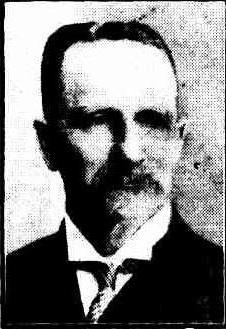 Mr. M. A. H. Fitzhardinge was a prominent figure in the aquatic world for
about 40 years. In his boyhood there was no ferry service between Balmain and
the city, and he and his brothers used to row their father to and from the city
each day. He was coxswain of the New South Wales four-oar crew in the first
race against Victoria, and stroked the New South Wales boat in the last
fixed-seat race.
Mr. M. A. H. Fitzhardinge was a prominent figure in the aquatic world for
about 40 years. In his boyhood there was no ferry service between Balmain and
the city, and he and his brothers used to row their father to and from the city
each day. He was coxswain of the New South Wales four-oar crew in the first
race against Victoria, and stroked the New South Wales boat in the last
fixed-seat race.
On one occasion, when they were young men, he and two brothers rowed from Sackville Reach, on the Hawkesbury River, to Sydney in an 18ft boat. Their intention was to go as far as Pittwater, and there take the Gosford steamer. Something interfered with the running of the latter, which was not on time, and as the day was fine and the sea smooth, the brothers pulled out of Broken Bay and safely completed the journey to Sydney in their rowing boat
Yachting was another of Mr. Fitzhardinge's pastimes, and his 24-footer, the Adelphi was well known on the harbour. He was formerly a member of the Sydney Rowing Club and the Sydney Amateur Sailing Club and was on the committee of the Anniversary Regatta and the Balmain Regatta for many years. He also did a lot of work as managing trustee of the Birchgrove Park. He unsuccessfully sought Parliamentary honours as representative of Balmain on two occasions being narrowly defeated. Having property interests at Marsfield, he was mayor and alderman when the area was first Incorporated. Church work also claimed his interest, and for a time he was a warden of St John's Balmain. His activities also embraced the Incorporated Law Institute of which he occupied the presidential chair at one period. For nearly the whole of his life he lived at Balmain. He moved to Mosman a few years ago.
He is survived by a widow, three sons and two daughters. The sons are Mr. Arthur Fitzhardinge who served in the South African and Great Wars, Dr H C Fitzhardinge of Macquarie-street, and Mr Roger Fitzhardinge, famous in rowing, athletics and lacrosse. The daughters are Miss Dorothy Fitzhardinge and Mrs A C Braham of Victoria. Two of his brothers are Judge G H Fitzhardinge and Mr Moreton Fitzhardinge, solicitor, of Parramatta. There will be a service in the chapel at the Northern Suburbs Crematorium at 11 o'clock this morning. OBITUARY. (1935, August 31). The Sydney Morning Herald(NSW : 1842 - 1954), p. 21. Retrieved from http://nla.gov.au/nla.news-article17175756
In relation to above article's report of a row to Sydney - See: Canoe and I Go With The Mosquito Fleet (1896)
The late Mr James T Langford, who was buried on Friday at St. Thomas' Cemetery, North Sydney, was well known in boat-building circles. The deceased's father, Mr. Thomas Langford, was a famous builder of open boats about 60 years ago, in conjunction with his brother William, building the Ione, Violet, Magic, and a number of fine yachts. He also built the well-known fast 15-footer Alice, and a very large open boat, the True Blue. In his later years he devoted his attention to 24-footers, the Mulga (now known as the Adelphi), owned by Mr M. A. Fitzhardinge, being one of his productions. PERSONAL. (1911, August 28). The Sydney Morning Herald(NSW : 1842 - 1954), p. 8. Retrieved from http://nla.gov.au/nla.news-article15269285
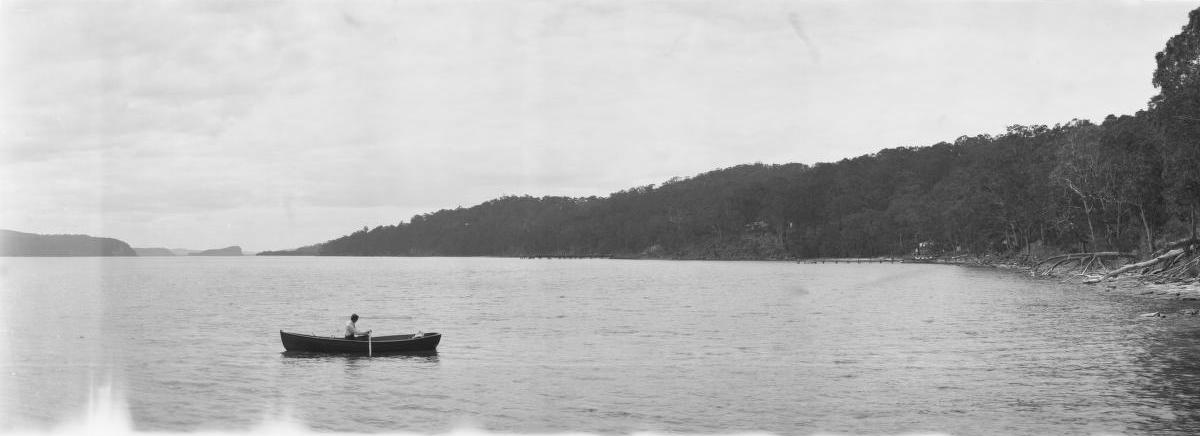
Panorama of Taylors Point, Pittwater, New South Wales, Part of Enemark collection of panoramic photographs [1917-1946] Image No.: nla.pic-vn6149423 and sections from showing jetties; Northern most and Below that - southern one, courtesy National Library of Australia.
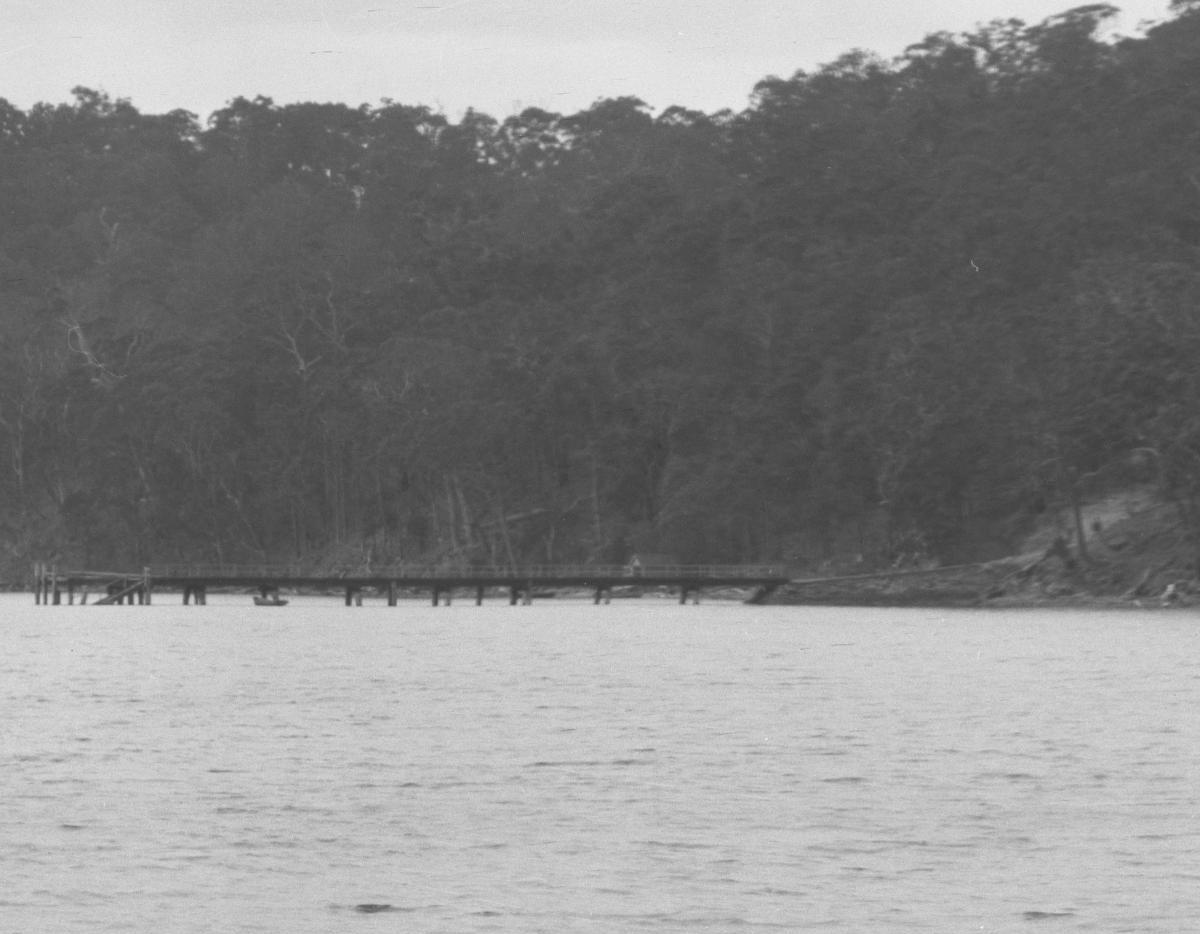
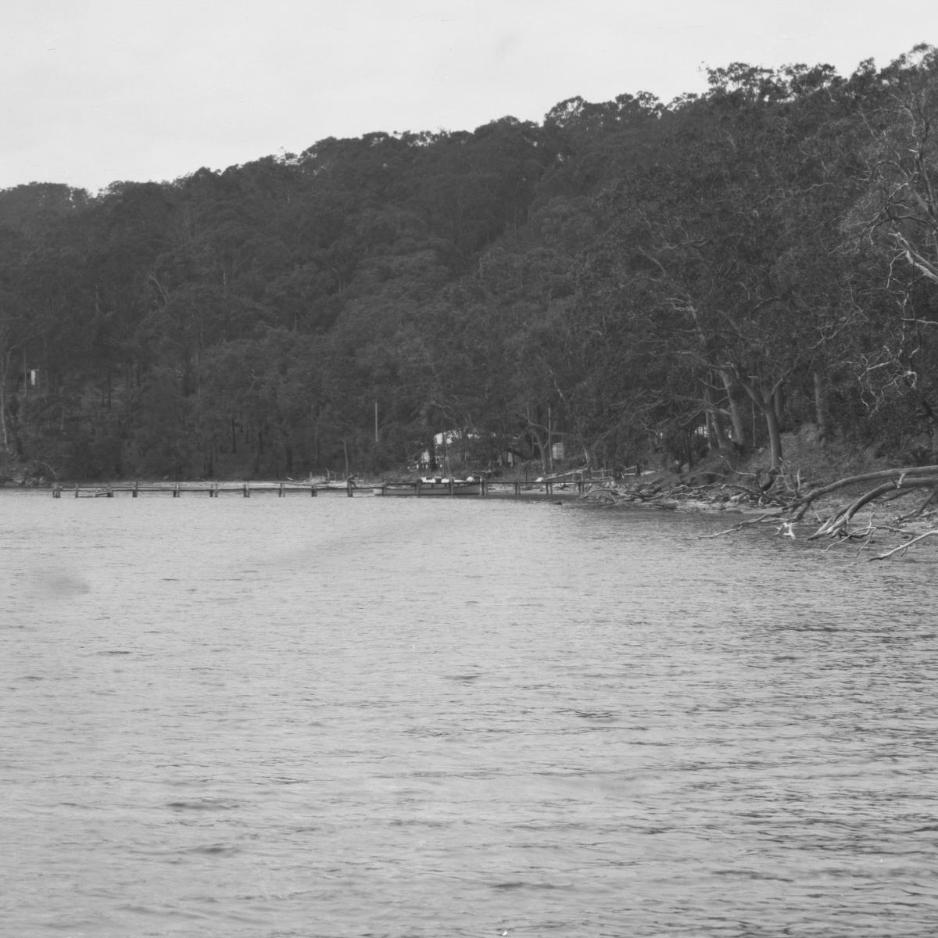
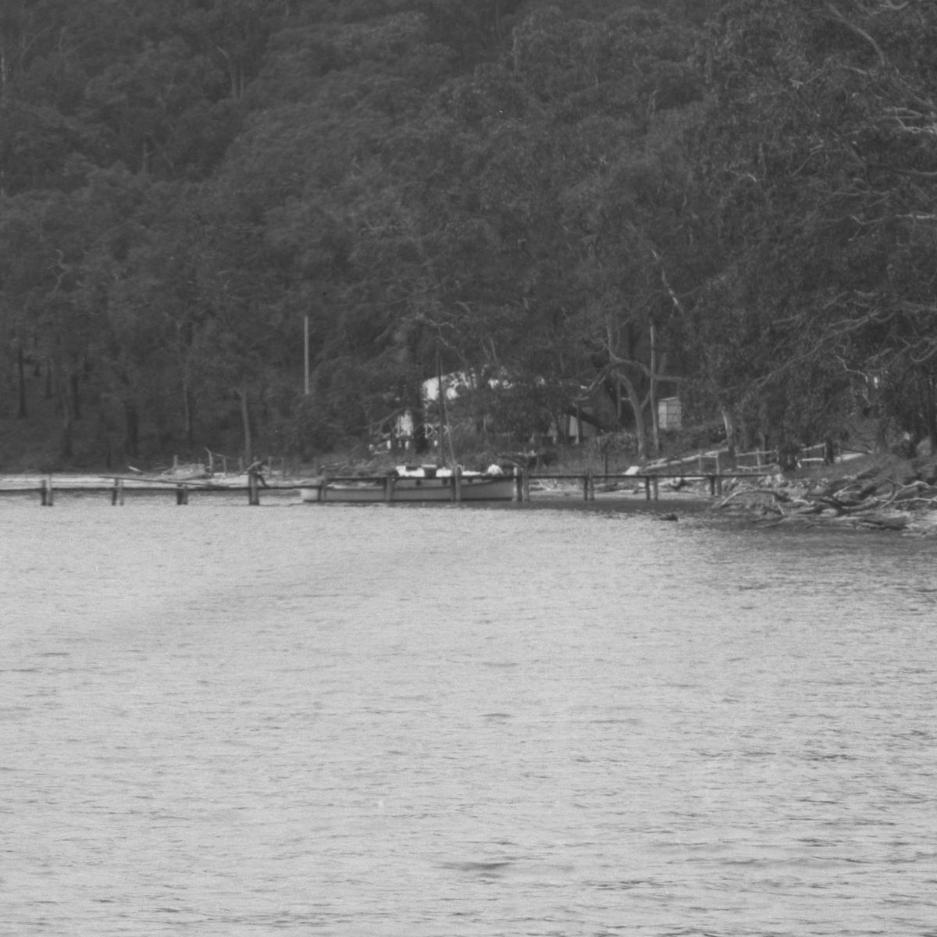
Communications with Pittwater - Ferries To Pittwater - threads collected and collated by A J Guesdon, 2014.